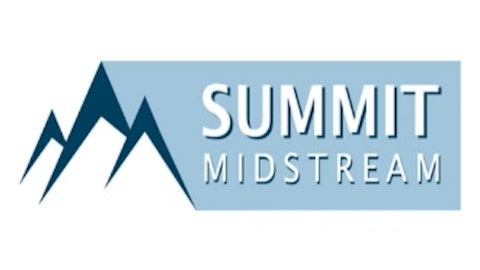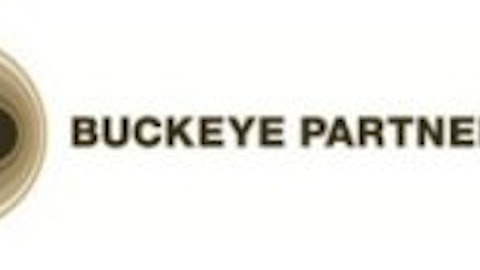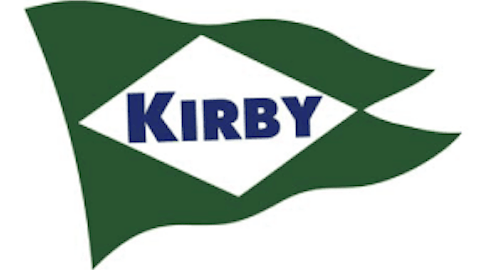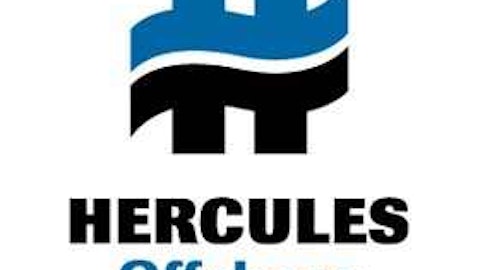Martin Midstream Partners L.P. (NASDAQ:MMLP) Q3 2023 Earnings Call Transcript October 19, 2023
Operator: Good morning. My name is Audra, and I will be your conference operator today. At this time, I would like to welcome everyone to the MMLP’s Third Quarter Earnings Conference Call. Today’s conference is being recorded. All lines have been placed on mute to prevent any background noise. After the speaker’s remarks, there will be a question-and-answer session. [Operator Instructions] At this time, I would like to turn the conference over to Sharon Taylor, Chief Financial Officer. Please go ahead.
Sharon Taylor: Thank you, Operator, and good morning, everyone, and thank you for joining us today. In the room are Bob Bondurant, CEO; Randy Tauscher, COO; David Cannon, Controller; and Danny Cavin, Director of FP&A. I will begin with our cautionary statement. During this call, management maybe making forward-looking statements as defined by the SEC. These statements are based upon our current beliefs, as well as assumptions and information currently available to us. Please refer to our press release issued yesterday afternoon, as well as our latest filings with the SEC for a list of factors that could impact the future performance of Martin and cause our actual results to differ from our expectations. We will discuss non-GAAP financial measures on today’s call, such as adjusted EBITDA, distributable cash flow and free cash flow.
In addition, we will refer to adjusted EBITDA after giving effect to the exit of the butane optimization business. You will find a reconciliation of these non-GAAP measures to their nearest GAAP measures in our earnings press release posted on our website. Now I will turn the call over to Bob to discuss second quarter results by segment.
Bob Bondurant: Thanks, Sharon. I would now like to discuss the performance of Martin Midstream’s operations, comparing the actual results of the third quarter to our third quarter revised guidance. As a reminder, the third quarter is typically our weakest cash flow quarter relative to the other three quarters of the year, primarily due to the seasonality in our fertilizer business, which is historically weaker in Q3. For the third quarter, we had adjusted EBITDA of $26.2 million, compared to our third quarter revised guidance of $25.1 million, an improvement over guidance of $1.1 million or 4.4%. For the treading 12 months ending September 30, 2023, excluding the results of our recently exited butane optimization business, we had adjusted EBITDA of $117.1 million.
For the third quarter, our largest cash flow generator was our transportation segment, which had adjusted EBITDA of $9.5 million, compared to revised guidance of $12 million. Within this segment, our land transportation business had adjusted EBITDA of $6.7 million, compared to revised guidance of $8.5 million. The miss in adjusted EBITDA compared to our forecast for the land transportation business was primarily due to an 8% reduction in forecasted miles driven. While the third quarter had the strongest daily load count of the year, our long-haul load count was down due to a slowing demand primarily from our specialty industrial customers. We believe this is due to the weakening U.S. economy. As a result of the weakened economic outlook, which we believe will negatively impact the transportation requirements from our specialty industrial customer base, we have lowered guidance for land transportation for the fourth quarter by $1.1 million.
Our marine transportation business had adjusted EBITDA of $2.8 million, compared to guidance of $3.5 million. While we missed guidance in the third quarter, we do see continued strength in both demand and daily market rates in the inland barge market. Compared to the second quarter, our average inland two barge tow day rate increased over 3%. However, negatively impacting our third quarter performance was a decrease in overall fleet utilization compared to forecast as one of our inland tows went into the shipyard for a lengthy dry dock. This inland tow is now currently working at an improved day rate. The other negative impact to third quarter performance was a one-time charge to marine transportation’s unallocated SG&A. Looking toward the end of the year, we feel comfortable with our existing fourth quarter guidance for marine transportation.
Our second strongest cash flow generator in the third quarter was our terminalling and storage segment, which had adjusted EBITDA of $8.2 million, compared to guidance of $9.1 million. We had a slight 1% revenue decrease compared to guidance and a 3% increase in total expenses, some of which were one-time charges. Now I would like to discuss the performance of our specialty products business segment, which was our third largest cash flow generator in the third quarter. In this segment, we had adjusted EBITDA of $6.8 million, compared to guidance of $5.2 million. While our combined NGL and propane groups met their third quarter guidance, our packaged lubricant and our grease businesses combined to exceed third quarter guidance by $1.7 million.
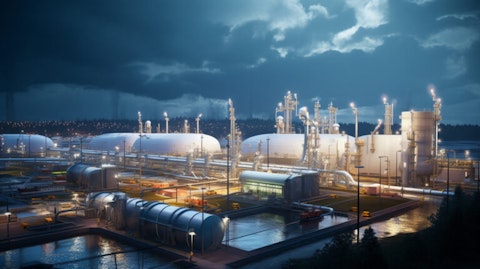
A bustling natural gas terminal, capturing the busy flow of energy selling and distribution. Editorial photo for a financial news article. 8k. –ar 16:9
Our sales volume for packaged lubricants and grease both approximated our forecast, but margins for both business lines exceeded forecast. Our packaged lubricant margins on a per gallon basis exceeded forecast by 35% and our grease margin on a per pound basis exceeded forecast by 19%. Finally, I would like to discuss our sulfur services segment. This segment had adjusted EBITDA of $5.4 million, compared to guidance of $3.1 million. Our fertilizer group had adjusted EBITDA of $2.2 million, exceeding third quarter guidance by $2.1 million, as we had forecasted a breakeven quarter. Our overall fertilizer sales volume exceeded forecast by 13%, as we had unforecasted liquid fertilizer sales to the South American export market. We also had unforecasted dispersal sales to the U.S. markets, as our customer base began to perceive that continued decline in dispersal pricing had floored due to upward pressure in sulfur commodity prices, the primary feedstock for dispersal.
Also, by having unforecasted liquid and dispersal sales in the third quarter, it allowed us to improve manufacturing utilization at two of our fertilizer plants, which also contributed to improved profitability. The pure sulfur side of our sulfur services segment had adjusted EBITDA of $3.2 million, which exceeded guidance by $0.2 million. We continue to see strong sulfur production from our refinery suppliers, which continues to support this business line with greater volumes and profitability than originally forecasted. To summarize, in the third quarter, we had strength in our margin businesses, offset to a certain degree by underperformance in some of our feed-based business lines. However, on a combined basis, Martin Midstream exceeded guidance by $1.1 million, confirming that in spite of certain cash flow variability between segments, overall, our restructured refinery services business model is designed to deliver long-term stable and sustainable cash flows.
Now I would like to turn the call over to Sharon to discuss our balance sheet, capital resources, leverage and capital investment.
Sharon Taylor: Thank you, Bob. Total long-term debt outstanding on September 30th consisted of $62.5 million drawn on our $175 million revolver that matures in 2027 and $400 million of senior secured second lien notes due 2028 for a total of $462.5 million, which is an increase of $2.5 million from the end of last quarter. The slight increase quarter-over-quarter was expected as the semi-annual payment for interest related to our outstanding notes was due in August of the quarter. Our total bank compliant leverage was 3.95 times at the end of the quarter, compared to 4.14 times on June 30th, a 0.19 times reduction driven by an increase in our trailing 12-month EBITDA after giving effect to the exit of the butane optimization business.
Rounding out our financial ratios, first lien leverage was 0.53 times and interest coverage was 2.2 times. Liquidity under the revolving credit facility was approximately $84 million and the partnership was in compliance with all covenants at the end of the quarter. Now let’s focus on capitalized spending during the quarter and how that projects for the rest of 2023. Maintenance capital expenditures for the quarter were $7.2 million, a slight increase from our forecast of $7.1 million. We are now forecasting maintenance CapEx to be $7.4 million in the fourth quarter, bringing our total for the year to $29.4 million, which is an increase of $2.8 million from our guidance. The majority of this increase is within the shore-based segment related to repairs on the Galveston bulkhead and to the Port Arthur dock structure.
Growth CapEx was $3.4 million for the quarter or $2.1 million less than forecasted. Capital expenditures related to the oleum tower, which will provide feedstock to the DSM Semichem joint venture was $2.6 million of the quarterly total. The original budget for 2023 related to the oleum tower was $12.7 million. However, we are now forecasting a total spend of only $7.2 million for the year, as construction costs are now more heavily weighted to the latter months of the project in the first quarter of 2024. Accordingly, the total growth CapEx forecast for 2023 is reduced, as we now expect 2023 spend to be approximately $10.1 million, compared to our guidance of $17.5 million. For clarity, year-to-date growth CapEx expenditures through the third quarter were $6.1 million, with an additional $4 million forecasted for the fourth quarter.
Distributable cash flow for the quarter was $5 million and adjusted free cash flow was $1.5 million. Finally, 2023 EBITDA guidance remains unchanged at $115.4 million, after giving effect to the exit of the butane business. We have adjusted fourth quarter guidance for the land transportation division down by approximately $1 million, but all other segments remain the same. For the full guidance by business line, please refer to slide three of the Third Quarter Earnings Summary presentation released along with our earnings yesterday evening and available on our website. This concludes my prepared remarks, so I will turn the call back to the Operator for Q&A.
See also 18 Most Popular Cereals in America and 13 Best Defense Stocks To Buy Now.
Q&A Session
Follow Martin Midstream Partners L.p. (NASDAQ:MMLP)
Follow Martin Midstream Partners L.p. (NASDAQ:MMLP)
Operator: Thank you. [Operator Instructions] We will take our first question from Kyle May from Sidoti & Company.
Kyle May: Hi. Good morning, everyone.
Bob Bondurant: Good morning.
Sharon Taylor: Good morning.
Randy Tauscher: Good morning.
Kyle May: Bob, wondering if you could maybe expand on the lower mileage in the transportation segment for this quarter, and I know you mentioned you have already made some adjustments for the fourth quarter, but just kind of how you are thinking about that aspect of the business and then when it could potentially turn around?
Bob Bondurant: Yeah. So big picture, as I made in my comments, was our total load count was the highest average per day in the quarter. So what does that mean? How is your mileage down when your load counts up? And we have had a shift to a shorter haul kind of scenario around refinery bases, et cetera, because the demand in long hauling is down, a lot of it coming from the chemical industry, some from longer term from the lubricant business, just the demand because the economic slowdown is happening. So when you think about it, as you run a shorter haul, that’s more expensive, you have got a higher pay rate to keep a driver employed, he’s got to get paid, even though he’s running shorter versus a longer term haul. So that’s one piece of it.
Another piece is the frequency of short-hauls, you have more over time, repair and maintenance related to that. So bigger picture, if you will, a shorter haul rate has probably a higher operating cost per mile it does versus a long-haul. So all that kind of plays into the equation. So when is this going to turn around? We have seen late in the third quarter pickup in our chemical hauling and it’s carried over a little bit into October. So hopefully that’s boding well for us. We are going to also try to increase our customer base. We have a fleet of chemical traders that need to have a higher utilization. So we are going to try and expand our chemical base — customer base, if you will. So all that combined, I think we are going to see a slower fourth quarter, overall, but probably, it will trend along with the U.S. economy, probably, later first quarter into the second quarter.
That’s our instinct. Any addition?
Randy Tauscher: Yeah. This is Randy. I just add that we have a seasonality aspect to the chemical and lubricant business and typically we see a little slowdown beginning around Thanksgiving time through the first of the year. But the element of the 4Q that we normally see an improvement is from the LPGs, particularly if we have any kind of long and sustained winter from the propane side. But our butane business or our customers in the butane business and our propane business typically elevates for the trucking department quite a bit in the fourth quarter and the first quarter.
Kyle May: Okay. Great. That’s helpful. And then I also wanted to ask about, I believe the release mentioned in some of your prepared comments, talked about delays in the semiconductor manufacturing facility. Just wonder if you can give us kind of an update on the current status of development and then should we expect any delays in the overall project completion?
Randy Tauscher: This is Randy again. So the answer to that is we expect a slight delay in the project completion and then now I am talking about our oleum plant to the second quarter of 2024 from late first quarter 2024. And then, yes, I mean, absolutely, when our intended customers are announcing delays of their plant, our demand will be kicked down the road a little bit, likely much of it into 2025.
Kyle May: Okay. Great. That’s helpful. Appreciate the time this morning.
Sharon Taylor: Thank you, Kyle.
Bob Bondurant: Thanks.
Operator: [Operator Instructions] We will go next to Selman Akyol with Stifel.
